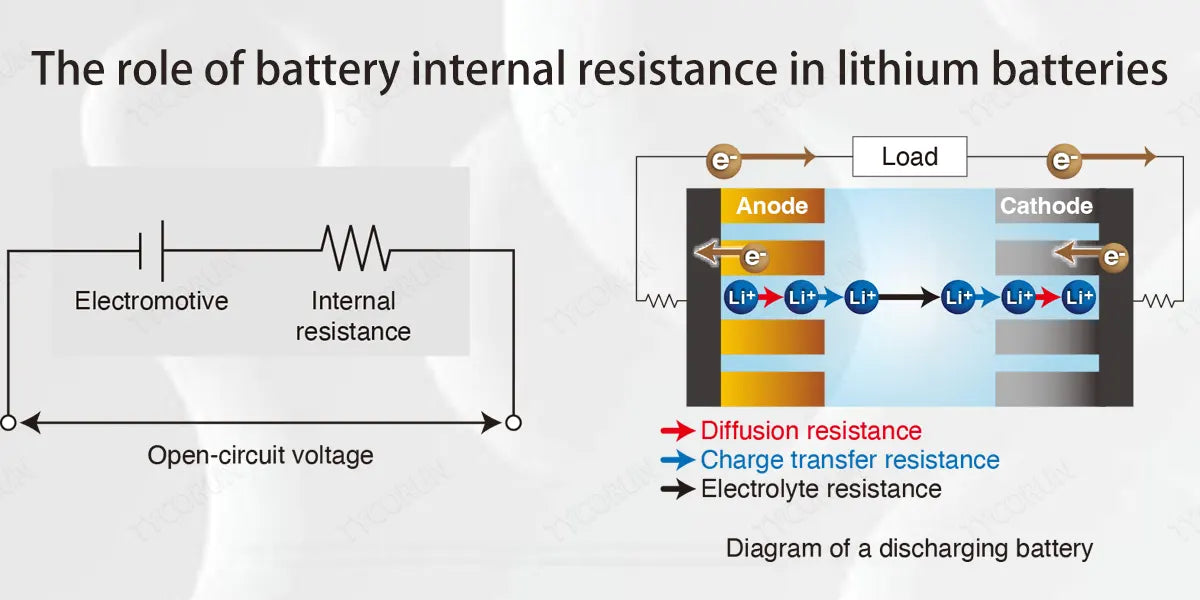
Main content:
- Definition of battery internal resistance
- The role of battery internal resistance in lithium batteries
- Factors influencing the internal resistance of the battery
- How to evaluate battery characteristics by DC internal resistance
- How to measure battery internal resistance
- A way to reduce the internal resistance of the battery
- Conclusion
As an efficient and environmentally friendly energy storage device, lithium batteries are widely used in electric vehicles, mobile communications, energy storage systems and other fields.
In the performance evaluation of lithium batteries, the battery internal resistance is an important indicator. In this article, we will introduce and analyze in detail the definition, measurement methods, influencing factors, and measures to improve the internal resistance of batteries.
1. Definition of battery internal resistance
Battery internal resistance refers to the resistance encountered by current through the inside of battery during the discharge or charging process of the lithium battery.
It is determined by a number of factors, such as the conductivity of the material inside the battery, the ion transmission rate of the electrolyte, and the contact resistance between the electrode and the electrolyte.
The internal resistance of battery directly affects the performance of the lithium battery, including output power, cycle life, temperature characteristics of battery, etc.
2. The role of battery internal resistance in lithium batteries
The battery internal resistance is one of the limiting factors for lithium battery output power. When the internal resistance of the batteries is large, a large voltage drop will occur when the current passes through the inside of the battery, resulting in a decrease in the output power of the batteries.

The battery internal resistance will produce self-discharge. Due to the presence of resistance inside the battery, the battery will also have a certain amount of current flowing through it when it is not working, resulting in the phenomenon of self-discharge of the battery.
The battery internal resistance affects the temperature characteristics. Batteries (12v 100ah lithium ion batteries) with larger internal resistance will generate more heat during discharge or charging, which will lead to an increase in battery temperature, which will further affect battery performance.
3. Factors influencing the internal resistance of the battery
The battery internal resistance is affected by many factors, including the following aspects:
- Conductivity of battery materials
Conductivity determines the rate at which current is transmitted inside the battery. The higher the conductivity of the material inside the battery, the lower the internal resistance.
- The ion transport rate of the electrolyte
The transport rate of ions directly affects the battery internal resistance. The faster the transport rate of ions in the electrolyte, the lower the internal resistance.
- Contact resistance between electrode and electrolyte
Contact resistance is also an important factor affecting internal resistance. The lower the contact resistance, the lower the internal resistance.

- Structural design of battery
The structural design will also have a certain impact on internal resistance. For example, the larger the electrode area of a battery, the lower the internal resistance.
- Temperature
Temperature also has a great influence on internal resistance. In general, the higher the temperature, the lower the internal resistance.
4. How to evaluate battery characteristics by DC internal resistance
In practical applications, DC internal resistance is often used to evaluate the health of lithium batteries, predict the life of lithium batteries, and estimate the SOC (State of Charge) and SOP (State of Power) systems.
By measuring the internal DC resistance of battery, information about the state of the batteries can be obtained. It provides a basis for battery management and control, and further improves battery efficiency and service life, as follows:
- Health evaluation
Lithium battery health refers to the degree of battery degradation during use, which is usually assessed by the rate of capacity decay and the rate of internal resistance increase.
The change in DC internal resistance can reflect physical and chemical changes inside the battery, so it can be used to evaluate battery health. When the health of a battery decreases, its internal resistance tends to increase.

- Life expectancy
The increase in the internal resistance of the battery is an important manifestation of lithium ion battery degradation. By monitoring the change in the internal DC resistance of the battery, the battery life can be predicted.
When the internal resistance of the DC increases to a certain level, it means that the battery life is close to or has exceeded its design life, and it needs to be replaced or repaired.
- System SOC estimation
The SOC of a battery refers to the current battery state of charge, which is the ratio of the available energy remaining in the battery to the total energy. There is a certain relationship between the internal DC resistance and the SOC of the battery, and the SOC of the battery can be estimated by measuring the internal DC resistance of the battery.
Based on the existing model of the internal resistance-charge relationship, the SOC of the battery can be estimated by measuring the internal DC resistance of the battery.
- System SOP estimation
The SOP of a battery refers to the current power state of the battery, i.e. the maximum power that the battery is capable of providing. There is also a certain relationship between the internal DC resistance and the SOP of the battery, and the SOP of the battery can be estimated by measuring the internal DC resistance of the battery.
According to the existing power-state relationship model of internal resistance, the SOP of the battery can be estimated by measuring the internal DC resistance of the battery. DC internal resistance plays an important role in health assessment, life prediction and system SOC and SOP estimation of lithium batteries.
5. How to measure battery internal resistance
There are two main methods of measuring battery internal resistance: static measurement and dynamic measurement.

● Static measurement methods
The static measurement method is to calculate the internal resistance of a battery by measuring the difference between the open-circuit voltage of the battery and the short-circuit current.
Specific steps are as follows:
- Leave the battery for a while so that the electrochemical reactions inside it tend to be in equilibrium.
- Measure the open-circuit voltage of the batteries. A load is inserted between the cathode and anode of the battery to measure short-circuit current.
- According to Ohm's law, the battery internal resistance is calculated.
● Dynamic measurement methods
The dynamic measurement method is to measure the internal resistance of the battery by applying an alternating current signal.
Specific steps are as follows:
- An alternating current signal is applied between the cathode and anode of the battery.
- Measure battery current and voltage signals.
- Based on the phase difference and amplitude ratio of the current and voltage signals, the battery internal resistance is calculated.
6. A way to reduce the internal resistance of the battery
In order to improve the performance of lithium batteries (12 volt 200ah lithium battery), some measures need to be taken to reduce the internal resistance. Here are some common methods:

- Optimize battery materials: By changing the composition and structure of the battery material, the conductivity of the battery material is increased.
- Optimize the electrolyte: Change the composition and concentration of the electrolyte to increase the ion transport rate in the electrolyte.
- Improved electrode-electrolyte contact: By changing the way the electrode contacts the electrolyte, the contact resistance between the electrode and the electrolyte is reduced.
- Optimize the design of battery structure: By changing the structural design of the batteries, the area of the electrodes is increased.
- Control the temperature: Reasonably control the working temperature of the battery to avoid excessive temperature.
7. Conclusion
The battery internal resistance is an important indicator in the performance evaluation of lithium batteries, which directly affects the output power, cycle life, temperature characteristics and so on of the batteries.
Through reasonable measurement methods and optimization measures, the internal resistance of the battery can be reduced and the performance of the lithium battery can be improved.
With the continuous progress of science and technology, it is believed that the internal resistance of lithium batteries will be further reduced, providing better support for the development of lithium battery applications.
Related articles: Top 5 battery electrolyte companies, Top 10 lithium battery companies in the world, lithium battery failure
















